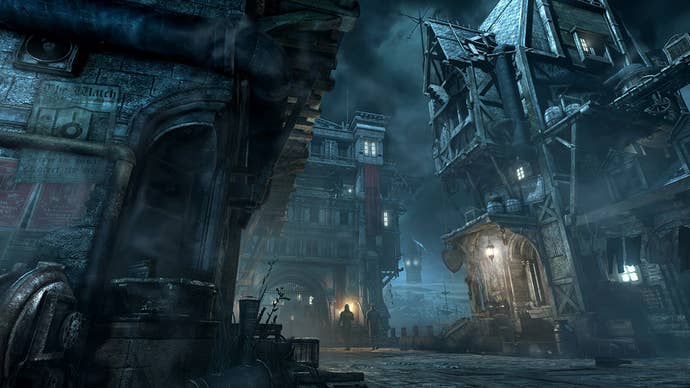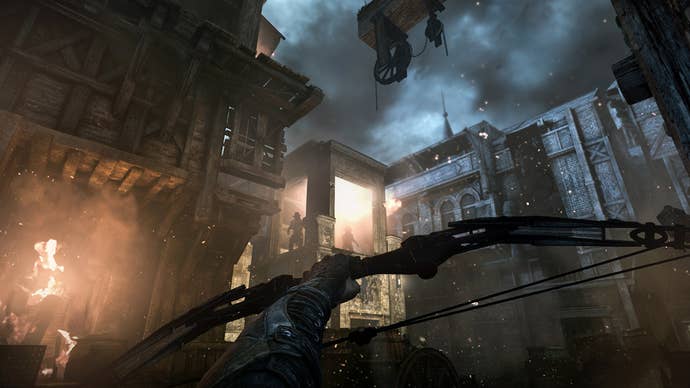The Living City: A Look at Thief's Excellent Open World
Thief's troubled reboot manages to rise above reproach in at least one area: The intricately crafted three-dimensional puzzle that is the City.
This article first appeared on USgamer, a partner publication of VG247. Some content, such as this article, has been migrated to VG247 for posterity after USgamer's closure - but it has not been edited or further vetted by the VG247 team.
Casing the area, I see no less than six guards wandering around the square, keeping a watchful eye not only on the well-lit open spaces but the deep shadows at its periphery as well.
Let's see: One standing just to my left, facing away from me; one, armed with a bow, keeping watch in the tower opposite my hiding place; another around the corner to my right, blocking the mouth of an alley and frequently chatting with a second archer who stalks back and forth between his two comrades at stationary posts; and two patrolling the street that stretches up the hill beyond the first guard. Experience tells me there's probably a seventh prowling back forth on the opposite side of the alley as well.
No matter how many times I've made my way through this intersection, it always makes me tense. It's the most expedient route through this district, but it's also one of the most heavily watched locations in the City. Every time I make this trip, I weigh the benefits of slipping directly through here or taking a more circuitous alternate route, and every time I decide to go with the direct route. Every time, I find myself wishing I'd gone the other way.

Square Enix's Thief reboot has problems, it's true. Even for someone like me, who never played the older games and experienced the new game free of the tyranny of expectations, the flaws show clearly. The poor mission design reduces a legendary franchise to another me-too AAA-wannabe, and dimwitted artificial intelligence really mutes the experience.
Nevertheless, even after finishing and reviewing the game, I still find myself coming back to it... and that's in spite of the enticing presence of a Final Fantasy XIV beta icon right next to Thief's on my PlayStation 4 dashboard. As much as I'm ready to be done with the jumbled mess of almost-great ideas and half-baked design, something keeps pulling me back. That something, I think, is the City.
I don't know exactly how previous Thief games worked, but the City plays the role of hub in this sequel. It's a massive, winding labyrinth of cobbled streets, rickety platforms, and obscure walkways that branches off into standalone missions set at its periphery; the eight chapters of the story transpire in self-contained spaces connected to but not really a part of the central hub. The environments in these main chapters possess a different feel than the core City, adopting a more linear style – sometimes there are even quick-time events and big Call of Duty-style explosive cinematics to contend with.

But the City itself – that is, the hub aspect of Thief – has such an utterly different style to it that it may as well be from a different game. It feels much more like what I get the impression long-time franchise fans regard as the platonic ideal of Thief. When they talk of stealth and multiple pathways and complex design, I see in my head this game's City. Whereas Thief's missions can be hopelessly hit-or-miss (often both within the space of a few minutes), the City rarely disappoints me.
On the contrary, I find the City one of the most intriguing pieces of environmental design I've ever come across in a game. For all intents and purposes, Thief's central hub takes the form of an open world; the City sprawls across several large areas that you can traverse at will, and it doesn't only contain links off to the mission environments. No, it also contains shops, quests, NPCs, obligatory collectibles, and tons of enemy guards on constant patrol. Yet it sets itself apart from typical open world environment with its density. The convoluted paths of the city can be tricky to navigate.
Generally, open-world design takes its name literally; nearly every video game open world I can think of tries to be not only "open" in the sense of offering players the freedom to roam at will, but also "open" in the sense of providing few barriers to that traversal. Sure, you'll come across minor threats as you wander about a game like Grand Theft Auto V, or Skyrim, or even a lesser example like Lightning Returns, but open worlds generally try to minimize friction as you're getting about to the meat of the game.
Not Thief. Its City offers several ways to move from place to place, but none of them are particularly brisk. You can traverse the City at street level, but those streets are heavily patrolled. The guard A.I. may be notoriously stupid, but even so you can't just take a brisk walk without giving a thought to concealment; step into one of the many brightly lit patches of pavement and even a distant soldier will notice you. Traveling via street requires dashing from shadow to shadow, waiting for a patrol to follow its routine, and making the most of opportunity.

The alternative mode of transport comes in traversal by rooftop, but this isn't as simple as in Assassin's Creed. The City resembles an old-world locale, where centuries of structures are built beside, atop, and even astride one another. It's not altogether realistic, with all those hoisted platforms just waiting to be dropped with a well-placed arrow strike to the joint of the cable suspending it; it is, however, convincing. It feels authentic, like a place where people have lived for hundreds of years and new construction sprouts up as best it can alongside whatever happens to be there. This is a place from before the time of zoning ordinances and civic planning. As I played, I kept thinking of Discworld's Ankh-Morpork, a similarly oppressive and filthy locale also constructed through the ages atop the ruins of itself – though generally a much wittier take on the concept than Thief's dreary citiscape.
In practice, the City's baroque layers turns the pursuit of alternate means of navigation into something akin to a puzzle. You can take on numerous client requests outside of Thief's main story, but unlike other open-world games completing them isn't as simple a matter as wandering over to the corresponding map marker. You can be standing mere inches from a waypoint yet have no idea how precisely to reach it. Executing a heist is invariably simple, but that's a reflection on the unimaginative mission goals, not the environmental design; the challenge of heists comes in finding a way into to your mark's home. The City offer's Thief's greatest challenge.
Granted, the City isn't without its flaws. While it steadily evolves over the course of the game to reflect the story – patrols change in their makeup and routes, and later, riots begin to reshape entire areas – once you work your way through the story it begins to stagnate. How long can these dusty old wooden buildings burn, you may wonder? Evidently forever.
A significant factor in the City's design, I suspect, comes from the fact that Eidos Montreal built the game around the limitations of last-gen consoles. As such, the City has been broken into districts in strange ways to reduce memory strain; while the divisions between areas make obvious sense on the street level, once you climb into the anarchic rooftops you'll encounter loading transitions at the strangest places. Sometimes you'll pry open a window or squeeze through a narrow passage and need to mash a button to do so, but at other – seemingly random! – times, there'll be a fade-out where the mini-QTE would normally go. The City's regions above and below don't line up into tidy consistent boxes, and you'll often find yourself walking along a rooftop over an area that technically belongs to a different part of the City. It can be extremely confusing, and the frequent, unpredictable load transitions create a sporadic feel that interrupts the flow of travel.

Even so, the multi-layered intricacy of Thief's City makes it one of the most fascinating video game locales I've explored. New details constantly make themselves known; long after I had finished the main story, I continued to stumble into treasure-laden alcoves I'd previously overlooked or spot grapple points for my rope arrows that allowed me to reach new areas. The gradual evolution of the City's layout leaves me wondering if I actually overlooked those nooks and details before, or if they simply hadn't previously been there until some unknown plot event or mission request triggered them.
I don't think it matters, though. The winding multitude of paths and miss-them-if-you-don't-look-closely secrets of the City work precisely the way they should: They turn the "throwaway" part of an open-world game (the act of getting from place to place) into a substantial and consistently engaging part of the experience. In fact, if Square Enix and Eidos choose to continue developing the Thief franchise, I truly hope it's the City and not the mundane, by-the-numbers story missions they use as the foundation for future sequels. The City is a confusing, depressing, dangerous place to skulk around... and that's precisely what makes it great.








